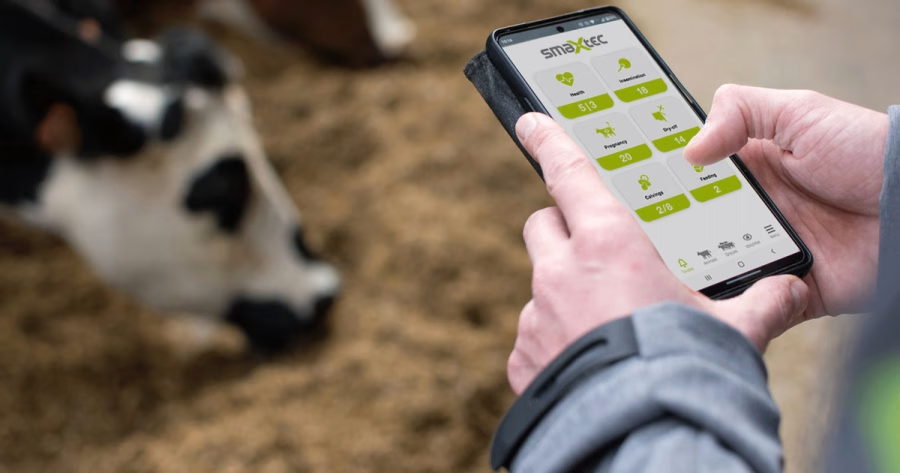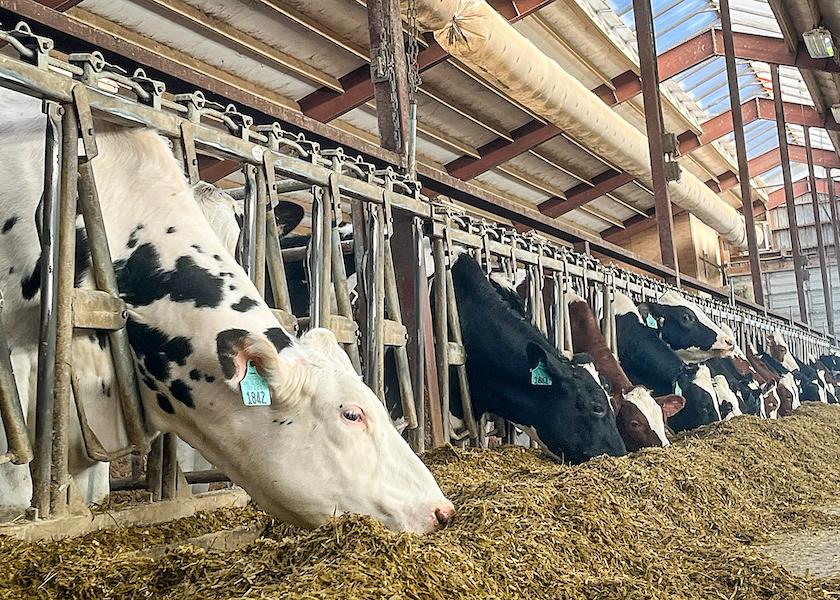Explore 8 new technologies that make it easier to find mastitis in dairy cows early. These innovations can help increase productivity and save money.

Imagine a bustling dairy farm where each cow is vital to the livelihood of the entire operation. Now, consider the effect if one of these cows develops mastitis. Early mastitis diagnosis is critical for animal welfare and preserving the farm’s financial viability. The development of sophisticated technology gives farmers creative means to address this problem effectively.
The integration of innovative technology into mastitis diagnosis has the potential to revolutionize dairy farming. New artificial intelligence techniques, infrared thermography, and augmented reality are not just tools but transformative forces in mastitis diagnosis. These advancements are expected to reduce the physical burden on farmers and ensure cows receive quick and efficient care, thereby preserving the overall output of the farm.
The Limitations of Conventional Mastitis Detection Methods
Though labor-intensive and time-consuming, traditional techniques for mastitis diagnosis—the California Mastitis Test (CMT) and bacterial cultures from milk samples—are dependable; they delay diagnosis using careful sample collecting and physical processing, therefore raising expenses. This can aggravate the problem and cause significant financial losses. Furthermore, burdening dairy farmers are the expensive laboratory testing expenses and the necessity for trained people, which makes early identification difficult and less effective.
Augmented Reality: Revolutionizing Dairy Cow Health Monitoring
By overlaying vital virtual information in the real world, augmented reality may alter farmers’ monitoring of dairy cow health. Farmers get real-time data and visual clues inside their range of vision using AR glasses or smartphone applications. Looking at a cow, for example, an AR system may display its temperature, milk production records, and movement patterns. This might point out symptoms of mastitis, such as higher udder temperature or lower milk supply, thus guiding farmers in making fast judgments. By guiding farmers through diagnostics, AR systems may provide step-by-step directions superimposed on the genuine cow, optimizing mastitis identification and treatment.
Infrared Thermography: A Noninvasive Approach to Mastitis Detection
Infrared thermography is an emerging, noninvasive diagnostic method for diagnosing mastitis in dairy cows. It produces thermographic photographs by translating infrared light from the skin of the udder into pixel intensity. These pictures show temperature fluctuations and indicate aberrant heat trends connected to mastitis. However, the precision of the technique might vary depending on things like udder hairiness, manure, and skin tone. Addressing these problems is crucial for a reliable diagnosis of mastitis.
The IoT: Pivotal in Mastitis Detection Through Wearable Sensors
The Internet of Things (IoT) changes mastitis detection in dairy cows through wearable sensors and sophisticated data-collecting systems. These motion, temperature, and rumination sensors are attached to many cow body parts. They communicate real-time data to cloud-based systems via high-speed internet and constantly check vital indicators.
Tracking body temperature, movement patterns, and rumination times—which point to cow health—the data reveals. This data is analyzed using advanced algorithms and artificial intelligence, and noise is filtered to spot mastitis signals. For instance, changing the temperature of the udder or shortened ruminating time can inform farmers early about any health problems.
Farmers get insights via easy-to-use tools that enable quick response. By distributing early-stage treatment to minimize economic losses and guarantee the herd’s health, this real-time monitoring system aids in swift, informed choices made by farm management. Through IoT, the dairy sector may embrace a proactive, precision-based strategy for improved output and sustainable farming.
Artificial Intelligence: Transforming Mastitis Detection Through Advanced Data Analysis
Artificial intelligence (AI) is a game-changer in mastitis detection, providing farmers with a reliable and precise tool for early illness symptom recognition. AI analyzes sensor data measuring temperature, movement, and milk content using machine learning algorithms to identify abnormalities suggesting mastitis. These AI systems, like seasoned veterinarians but with more precision, learn from data, see trends, and act quickly. This reliability and accuracy of AI provide farmers with timely, practical information, transforming dairy herd management and providing a sense of security and reassurance.
Electronic 3D Motion Detectors: Sophisticated Solutions for Continuous Health Monitoring in Dairy Cattle
Electronic 3D motion detectors, particularly helpful for mastitis diagnosis, provide a sophisticated approach for ongoing health monitoring in dairy cattle. Usually made of a battery, a data transmitter, and sensors—which may be buried in neck collars, ear tags, leg tags, and so forth—these detectors also include sensors arranged deliberately to track behavior and physical activity.
Set intervals allow them to gather and send data to a central system for processing, therefore recording movement patterns, rumination activity, and physiological characteristics. Many times, algorithms have examined this data using cloud computing. Alerts are set up for quick response when variations suggest possible mastitis. In this sense, early mastitis identification and treatment depend critically on electronic 3D motion detectors.
Deep Learning: Harnessing Neural Networks for Precision Mastitis Detection
A subset of machine learning, deep learning models brain activities using multi-layered neural networks. This method is excellent for making forecasts and identifying trends. Computer vision models also help effectively identify dairy cow mastitis.
These models identify mastitis with an excellent 96.1% accuracy by using deep-learning algorithms to evaluate photos of dairy cows. This great accuracy highlights how well deep learning interprets challenging visual input.
Deep learning with udder ultrasonography improves mastitis diagnosis. This noninvasive imaging technique offers precise and quick identification by giving thorough pictures of udder tissue. This combo transforms dairy cow health management by increasing accuracy and providing a reasonably priced substitute for conventional laboratory testing.
5G Technology: A Game-Changer for Real-Time Mastitis Detection in Dairy Farming
5G technology transforms linked devices in dairy farming and significantly improves mastitis diagnosis. Low latency and fast connections let 5G support many wearable sensors and smart devices on dairy farms. These gadgets provide real-time data to cloud-based systems that monitor essential factors such as milk production, body temperature, and mobility.
Early mastitis detection depends critically on real-time data collecting and analysis, which 5 G makes possible. By enabling farmers to immediately see abnormalities, forecast mastitis start, and act fast, instantaneous data sharing helps lower mastitis frequency and intensity. This enhances herd health and production and lowers treatment expenses. 5G ultimately improves dairy cow health monitoring and streamlines agricultural processes.
Cloud Computing: Revolutionizing Real-Time Data Integration for Mastitis Detection
Cloud computing makes rapid data collection and sharing possible by linking devices in real-time. This integration enables dairy farms to compile data and provide a current picture of calf health using wearable sensors, environmental monitors, and farm management software.
Cloud systems offer significant benefits, including scalability and adaptability. As herds develop, farmers may increase their surveillance without major infrastructure modifications. The capacity to rapidly evaluate vast data quantities guarantees fast mastitis diagnosis using temperature, rumination, and activity measurement, resulting in early veterinary treatments, minimum economic losses, and improved animal welfare.
Advanced analytical tools and machine learning algorithms used on cloud platforms help to find trends in data, therefore enhancing the accuracy of mastitis detection. By turning unprocessed data into valuable insights, dairy producers may maximize animal health and output and make wiser choices.
The Bottom Line
Embracing a technological revolution, the dairy sector is improving early and precise techniques of mastitis diagnosis. While Infrared Thermography offers a noninvasive method to examine udder surface temperatures using thermographic pictures, Augmented Reality (AR) gives real-time insights into cow health. Artificial intelligence (AI) uses data analytics to identify exact illnesses. At the same time, the Internet of Things (IoT) monitors physiological indicators via linked sensors. Deep learning uses neural networks for great diagnostic accuracy, while electronic 3D motion detectors observe behavioral changes. Whereas Cloud Computing synchronizes data for instantaneous analysis, 5G technology guarantees fast data transfer for real-time monitoring.
Even with these developments, the dairy sector must solve sensor accuracy, data integration, and infrastructural requirements. Refining these technologies can help dairy farming become a more profitable, data-driven business by improving mastitis detection, guaranteeing improved animal health, and increasing production.
Key Takeaways:
- Augmented Reality: Integrates virtual elements with the real world to provide real-time health monitoring.
- Infrared Thermography: Non-invasive method converting infrared radiation into thermographic images to identify elevated udder temperatures.
- Internet of Things (IoT): Employs wearable sensors and connected devices to monitor and detect mastitis through data sharing and processing.
- Artificial Intelligence: Utilizes machine learning to analyze sensor data, providing early detection and actionable insights.
- Electronic 3D Motion Detectors: Monitors cow activity through various sensors and transmits data for continuous health assessment.
- Deep Learning: Implements neural networks and computer vision models for high-accuracy mastitis diagnosis.
- 5G Technology: Ensures real-time data collection and low latency, enhancing continuous monitoring capabilities.
- Cloud Computing: Offers scalable, real-time data integration, and computing solutions to aid mastitis monitoring.
Summary:
Advanced technology is revolutionizing mastitis diagnosis in dairy farming, reducing the physical burden on farmers and ensuring quick and efficient care for cows. Traditional methods like the California Mastitis Test (CMT) and bacterial cultures from milk samples are labor-intensive and time-consuming, leading to delayed diagnosis and financial losses. Augmented reality (AR) overlays virtual information in the real world using AR glasses or smartphone applications, providing step-by-step directions for mastitis identification and treatment. Infrared thermography is an emerging noninvasive diagnostic method that produces thermographic photographs by translating infrared light from the skin of the udder into pixel intensity. The Internet of Things (IoT) is pivotal in mastitis detection through wearable sensors and sophisticated data-collecting systems. Artificial intelligence (AI) is a game-changer in mastitis detection, providing farmers with a reliable and precise tool for early illness symptom recognition. Electronic 3D motion detectors are sophisticated solutions for continuous health monitoring in dairy cattle, particularly for mastitis diagnosis. Deep learning models brain activities using multi-layered neural networks and computer vision models help identify dairy cow mastitis with an excellent 96.1% accuracy. 5G technology transforms linked devices in dairy farming, allowing for low latency and fast connections. Cloud computing revolutionizes real-time data integration for mastitis detection.












